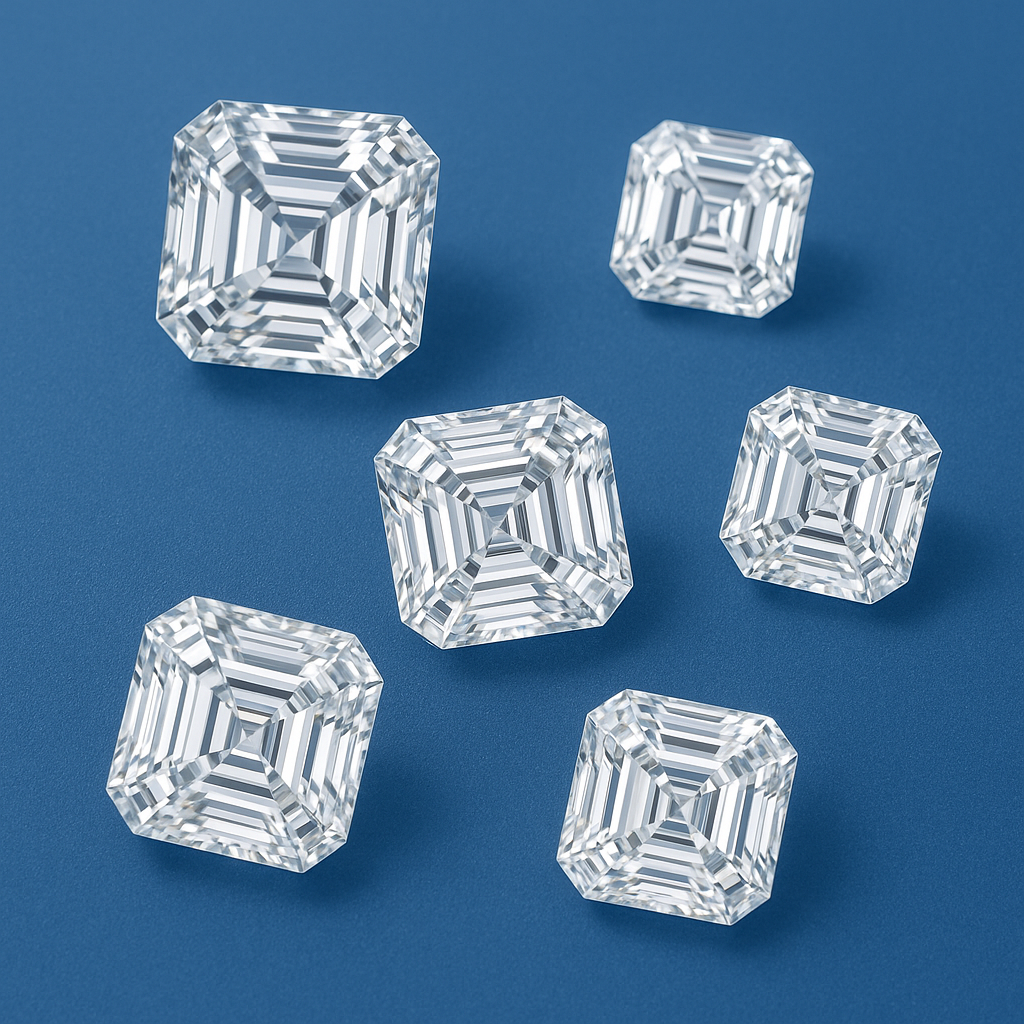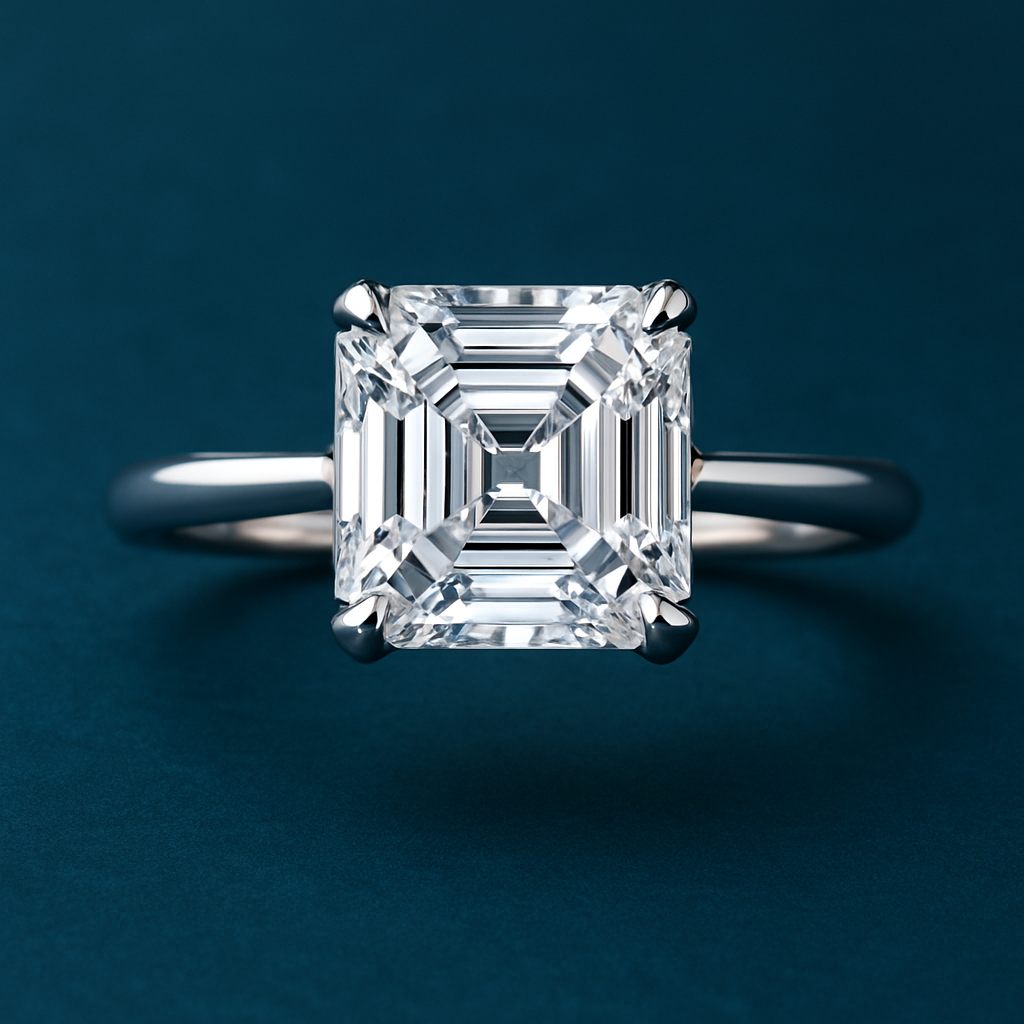Asscher Cut Diamonds: The Complete Guide to Vintage Glamour & Timeless Art Deco Style
🌟 Introduction: Why Asscher Diamonds Define Vintage Elegance

Geometric, refined, and bursting with Art Deco charm — the Asscher cut diamond is one of the most distinctive and elegant shapes in fine jewelry. Recognizable for its octagonal shape, cropped corners, and step-cut facets, the Asscher is often described as the “square emerald cut” with more brilliance and depth.
Created in the early 20th century and revived in the 2000s, Asscher cuts appeal to those who appreciate vintage glamour, bold symmetry, and understated sophistication. From antique-inspired solitaires to glamorous halos, Asscher diamonds capture a unique “hall-of-mirrors” sparkle that’s unlike any other cut.
In this complete guide, we’ll explore the history, design, 4Cs, buying strategies, celebrity examples, myths, FAQs, and expert insights about Asscher diamonds — giving you everything you need to decide if this vintage-meets-modern cut is right for you.
📜 A Distinctive History: From Amsterdam to Art Deco
🔹 The Original Asscher Cut (1902)
The Asscher cut was created in 1902 by Joseph Asscher, a master cutter from the Royal Asscher Diamond Company in Amsterdam. His family’s company quickly became world-renowned for precision and artistry.
🔹 The Art Deco Era
By the 1920s and 1930s, the Asscher cut perfectly matched the Art Deco aesthetic — bold geometric lines, symmetry, and sophistication. It became one of the most iconic cuts of the era, appearing in many vintage engagement rings and estate pieces.
🔹 The Royal Asscher Cut (2001)
In 2001, Joseph Asscher’s descendants refined the design, creating the Royal Asscher Cut, with 74 facets (instead of the original 58). This version maximized brilliance while retaining vintage charm.
💡 Real-World Example: The Asscher Diamond Company was also chosen to cut the legendary Cullinan diamond — the largest rough diamond ever found.
💡 What Makes Asscher Diamonds Unique?
Asscher cuts stand out for their step-cut faceting, symmetry, and hall-of-mirrors effect.
- Shape: Square with cropped corners, forming an octagon.
- Facets: 58 in original Asscher, 74 in Royal Asscher.
- Sparkle: More brilliance than emerald cuts, but with the same elegant flashes.
- Vintage Appeal: Strong association with Art Deco jewelry.
- Depth: Often cut deeper, creating a “endless stairway” look.
📊 Fun Fact: Asscher cuts account for less than 2% of diamonds sold, making them one of the rarest shapes on the market.
🔍 The 4Cs of Asscher Diamonds
1. ✂️ Cut: Symmetry is Everything
The beauty of an Asscher lies in its precision and symmetry.
- Depth %: 60–70% ideal.
- Table %: 60–68% ideal.
- Length-to-Width Ratio: 1.00–1.05 (perfect square).
- Polish & Symmetry: Must be excellent for crisp reflections.
💡 Pro Tip: Poor symmetry makes Asschers look “off” — always view the stone directly or in 360°.
2. 🎨 Color: Step Cuts Show Tint More Easily
Because Asschers have large, open facets, color is more visible.
- Best for White Metals: D–G color grades.
- Warmer Metals: H–I colors can look beautiful in yellow/rose gold.
- Fancy Colors: Asschers highlight colored diamonds (yellow, pink, green) exceptionally well.
3. 🔍 Clarity: Every Flaw is Visible
Asschers demand higher clarity than brilliant cuts. Their large tables act like windows, exposing inclusions.
- Best Value: VS1 or higher.
- Minimum: VS2 (SI1 rarely works unless inclusions are at edges).
- Expert Tip: Always examine Asschers under magnification before buying.
4. 💎 Carat: Depth Affects Size
Asschers carry more weight in their depth, meaning they look smaller face-up than rounds.
- A 1.0ct Asscher may look closer to a 0.85ct round in diameter.
- Consider going up in carat size for more presence.
- Their bold, symmetrical shape creates strong visual impact even at smaller sizes.
💡 Example: A client chose a 1.25ct Asscher over a 1.0ct round. Despite measuring smaller, the Asscher’s symmetry and depth made it appear just as striking.
💍 Asscher Diamonds in Engagement Rings
Asschers pair beautifully with both vintage and contemporary settings.

Popular Settings:
- Solitaire: Highlights the cut’s geometry.
- Halo: Adds sparkle and softens the square edges.
- Three-Stone: Asscher center with tapered baguette or trapezoid sides.
- Vintage-Inspired: Perfect for Art Deco-style rings with milgrain and filigree details.
Celebrity Inspiration:
- Elizabeth Taylor → Owned a famous Asscher-cut diamond ring.
- Gwyneth Paltrow → Wore an Asscher engagement ring from Chris Martin.
- Jessica Alba → Chose a 5ct Asscher solitaire.
Looking for precision brilliance? Read our transparent Brian Gavin Diamonds review.
🏆 Advantages of Asscher Diamonds
- Vintage glamour → Perfect for Art Deco lovers.
- Unique rarity → Far less common than rounds or princesses.
- Hall-of-mirrors sparkle → Elegant flashes vs fiery brilliance.
- Strong presence → Bold, architectural appeal.
- Affordable value → Often cheaper than rounds.
⚖️ Asscher vs. Other Shapes
| Feature | Asscher Diamond | Emerald Diamond | Round Diamond | Princess Diamond |
|---|---|---|---|---|
| Brilliance | ⭐⭐⭐ | ⭐⭐ | ⭐⭐⭐⭐⭐ | ⭐⭐⭐⭐ |
| Vintage Appeal | ⭐⭐⭐⭐⭐ | ⭐⭐⭐⭐ | ⭐⭐ | ⭐⭐ |
| Rarity | ⭐⭐⭐⭐⭐ | ⭐⭐⭐ | ⭐ | ⭐⭐ |
| Face-Up Size | ⭐⭐ | ⭐⭐⭐ | ⭐⭐⭐⭐ | ⭐⭐⭐ |
| Price Premium | Medium | Medium | High | Low |
💰 Pricing & Smart Buying Tips
- Asschers are 20–40% cheaper than rounds of the same weight.
- Prioritize clarity (VS1+) over carat.
- Opt for excellent symmetry & polish.
- Lab-grown Asschers provide identical sparkle for ~60% less.
🌍 Ethical & Sustainable Asschers
- Lab-Grown Asschers: Affordable, conflict-free, and identical to mined.
- Vintage/Antique Asschers: Popular in Art Deco rings — sustainable and historically rich.
- Conflict-Free Diamonds: Certified through Kimberley Process.
🎯 Advanced Tips
- Ratio: 1.00 for perfect squares; slightly rectangular Asschers are rare.
- Step-Cut Beauty: Expect flashes, not fiery sparkle.
- Lighting Test: Asschers reveal everything — inspect carefully in different lights.
Struggling to find a cheap and good place to buy your engagement diamond ring? Look no further than Ritani.
❓ Extended FAQ on Asscher Cut Diamonds
Are Asschers the same as emerald cuts?
No. Both are step cuts, but Asschers are square with a distinctive X‑shaped “windmill” pattern; emeralds are typically rectangular with longer parallel steps. Asschers usually have a higher crown and deeper pavilion, which changes how they return light.
Do Asschers sparkle?
They don’t “twinkle” like rounds. Instead, Asschers create bold, on‑off flashes and dramatic contrast—the classic “hall of mirrors.” They come alive under directional light (think evening or gallery lighting).
Do Asschers look bigger than rounds?
No. Because they’re deeper, Asschers face up smaller for the same carat. (As a rough idea: a 1 ct Asscher is ~5.5–5.7 mm; a 1 ct round is ~6.4–6.5 mm.) The square outline and crisp corners still give strong finger presence, and halos can boost apparent size.
What clarity is best?
VS1 or better is a safe target because step facets don’t hide inclusions well. An eye‑clean VS2 can be great too—avoid dark crystals under the table and feathering near corners. Always review magnified photos/video.
Do Asschers show color more?
Yes. Their big open facets make body color easier to see. For a “icy” look in white metals, aim G–H (or better); in yellow/rose gold, many people like H–I for a softly warm tone. Fluorescence can sometimes make near‑colorless stones appear whiter (just ensure it doesn’t look hazy).
Are Asschers durable?
Yes. Cropped corners reduce snagging and chipping risk vs. sharp‑cornered princess cuts. Still, protect the corners with sturdy prongs or a bezel, and avoid very thin girdles.
Do Asschers look good in halos?
Absolutely. Halos add scintillation and amplify size. An octagonal or square halo mirrors the Asscher outline beautifully; micro‑pavé or a fine milgrain bezel can lean vintage or modern.
Are Asschers vintage or modern?
Both. Born in the early 1900s and iconic in Art Deco jewelry, they’re continually reinterpreted today. You’ll see classic antique‑style cuts as well as modern precision cutting (including branded multi‑facet variants).
Are lab‑grown Asschers real?
Yes. They’re diamond—same crystal structure and optical properties—just grown by CVD/HPHT rather than mined. Insist on an independent grading report and a laser inscription for transparency.
Do Asschers cost less than rounds?
Generally yes—often ~20–40% less than a comparable round because demand and cutting yield differ. (Exact spreads vary by carat, color/clarity, and cut quality.)
Do Asschers hold resale value?
Not as strong as rounds, which dominate the market. That said, well‑cut Asschers remain desirable to step‑cut lovers; branded or antique pieces can have niche appeal. Buy for love, not investment.
What settings work best?
They shine in solitaires (clean, architectural lines), halos (extra sparkle/size), and vintage‑inspired designs with baguettes, traps, or a delicate bezel. Compass/talon prongs and kite‑set (on the point) arrangements add character.
Are Asschers rare?
Yes. They’re a small single‑digit share of the market (often cited under ~2%), so inventory can be tighter. Be patient and compare several stones side‑by‑side (video helps a lot for step cuts).
Do Asschers flatter all hands?
Yes, if you like a bold, square look. They won’t elongate the finger like ovals/emeralds, so pair with a thin band, tapered sides, or an octagonal halo if you want a sleeker visual line.
Are Asschers trendy or timeless?
Timeless. They’ve been style staples since the 1920s and keep cycling back into fashion. Their crisp geometry feels both classic and fresh.
🔮 Myths & Misconceptions
- Myth 1: Asschers don’t sparkle.
Reality: They sparkle differently — with flashes, not continuous fire. - Myth 2: Asschers are outdated.
Reality: They’ve been revived and are highly fashionable today. - Myth 3: All Asschers look the same.
Reality: Symmetry, depth, and facet style make huge differences.
📌 Conclusion: Is an Asscher Diamond Right for You?
If you want a diamond that is:
✔ Vintage-inspired and glamorous
✔ Bold, geometric, and sophisticated
✔ Rare and distinctive
✔ Elegant in both solitaire and Art Deco settings
…then the Asscher cut diamond may be your perfect choice.
With its historic roots, architectural beauty, and unique hall-of-mirrors effect, the Asscher cut remains one of the most sophisticated and timeless diamond shapes — perfect for those who want something elegant, rare, and full of character.

